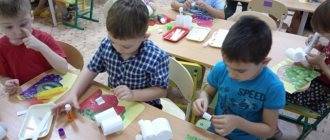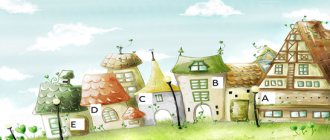Child and society article on the topic
CHILD AND SOCIETY
Relationships with other people begin and develop most intensively in preschool age. The first experience of such relationships becomes the foundation on which further personal development is built. The subsequent path of his personal and social development, and therefore his future fate, largely depends on how the child’s relationships develop in the first group of peers in his life - in the kindergarten group.
As studies have shown, at different stages of a child’s genetic development, the main communicative need changes and becomes more complex. Thus, in children 2–4 years old, the main communicative need is the need for the complicity of a peer, which is expressed in the simultaneous and identical actions of children. Children between the ages of 4 and 6 years old develop a need for joint activities with peers. At the age of 6–7 years, stable selective preferences between children develop.
Young children are often “captured by emotions” because they cannot yet control their feelings, which leads to impulsive behavior and difficulties in communicating with peers and adults. The problem is that children are egocentric; as a rule, in relation to other people, their own “I” often prevails.
The task of a teacher, an adult, is to help a preschooler develop a sense of self-confidence, teach him to consciously perceive the emotional state of himself and those around him, and also build relationships in interaction.
Emotions play an important role in children’s lives: they help them perceive reality and respond to it. The little man encounters the diversity of the world around him: objects, events, people. His parents introduce him to everything that surrounds him. Adults always, in one form or another, express their attitude towards things and phenomena using intonation, facial expressions, gestures and speech. While learning about the world around us, the child receives standards of relationships and displays a pronounced and selective attitude towards both objects and people. The child clearly distinguishes his loved ones from the people around him, showing his emotional state, makes it clear to his loved ones what he likes and what makes him angry.
In recent years, significant changes have occurred in the emotional sphere of the child. This is influenced by many factors: on the one hand, stressful situations, adult problems, low living standards, and on the other hand, the technologization of life. More and more children are appearing with disorders in psycho-emotional development, which include emotional instability, hostility, aggressiveness and anxiety.
An adult’s inattentive attitude towards a child significantly reduces his social activity: the child withdraws into himself, becomes constrained, insecure, ready to cry or take out his aggression on his peers.
The main goal of my activity is to promote the mental and personal growth of the child, creating an emotional happy mood in the group.
But the teacher also needs the help of parents, because mother and father are the first and main educators. They teach children to understand people and value life. They pass on the best to their children. Society is a huge house built from small bricks - families. And strong bricks mean a strong house. The interests of father and mother should be directed towards a common goal: to raise children physically and morally healthy.
Family feelings become a school of personal spiritual qualities for children. From these feelings, children learn love, friendship, submission and leadership, and learn to be a man and a woman.
Teaching a child to see and understand people is perhaps the most difficult thing in the difficult task of raising a person. Parental love should be such that the child awakens the sensitivity of the heart to the world around him, to everything that a person creates, that serves a person, and, of course, first of all, to the person himself. The feelings on which a good family of good people relies are similar to building blocks of happiness, and from them you can create an island of “home paradise”. Family can be the main source of happiness in our lives, but under one condition: treat others as yourself, try to give others and yourself this happiness.
Lesson-game “Me and Me, Me and Others”
Target:
team building, stress relief.
Training rules:
1. Rule of activity. All participants take an active part in discussions and completing assignments.
2. “Here and now.” During work, participants discuss only those issues that are significant at a given time.
3. “1 microphone.” With this rule, we remind participants that interrupting each other, even when discussing a very interesting topic, is unacceptable.
4. The principle of benevolence. This rule means that we treat other participants kindly and respectfully, and try to support and help them.
5. Principle of confidentiality. This rule means that everything that we discuss and hear must remain between us and not be taken out of the audience door.
Introductory stage.
1. Exercise “Threads of Happiness”
Purpose: warming up the group.
Now you and I will be wizards who can do anything. I suggest you weave a fabric of happiness. To weave a cloth, we need threads. In my hands is a skein of ordinary thread. Today we will turn them into Threads of Happiness. Stand in a circle closer together so that you can feel each other. We will pass (throw) a ball of threads to each other. Whoever has a skein of thread must compliment the participant to whom the skein of thread will be given. An ordinary skein of threads, making its way from one person to another, becomes a skein of Threads of Happiness.
(After everyone complimented each other). We are all connected to each other by threads of happiness. As a result, you and I received the Fabric of Happiness, which we ourselves wove. All happiness is in our hands!
Issues for discussion:
— Did you like the compliment?
— Was it pleasant for you to receive a compliment?
— What is more pleasant to receive or give a compliment?
2. Exercise “Swap places those who...”
Goal: getting to know the training participants, creating a comfortable situation in the group, aimed at physical activity.
Instructions: “Now we will have the opportunity to learn more about each other. Let's do it this way: the person standing in the center of the circle (for starters, it will be me) offers to change places (change seats) to all those who have some common characteristic. He calls this sign. For example, I will say: “Change seats, all those who have sisters,” and everyone who has sisters should change places. At the same time, the one who stands in the center of the circle must try to have time to take one of the places, and the one who remains in the center of the circle without a place will continue the game.”
Discussion: When the exercise is completed, the trainer can ask the group, “How are you feeling?” or “How are you feeling now?”
This exercise is fun with children. It helps reduce tension, lifts your mood, and activates attention and thinking.
Main stage.
1. Exercise “Rain”
Participants stand in a circle one after another and place their hands on the shoulders of the person in front. With light touches, each participant imitates drops of beginning rain. Drops fall more often, the rain becomes stronger and turns into downpour. Large streams flow down the back. Then the flows become smaller, the drops become less frequent and stop completely.
Discussion: How did you feel?
2. Game "Associations"
A person is selected and stands in front of the participants. The psychologist invites each person present, in turn, to say what associations this participant evokes for him, i.e. what it reminds us of: a plant, an object, an animal.
Discussion: What we felt, what comparisons were unexpected.
3. Exercise “Tangle”
Participants stand in a line and take each other’s hands, then the first one begins to twist around its axis and pulls the others along with it until a “spiral” is formed. In this position, participants must walk a certain distance. You can invite the group to carefully squat down at the end of their movement.
Discussion: What was difficult to do and what was easy?
4. Game-exercise “Garbage Bin”
The training participants write their negative thoughts, unpleasant incidents, stories, situations on sheets of paper, crumple the sheets and throw them into a bucket (forgetting it forever).
Discussion: How did you feel after throwing negative thoughts into the trash bin?
5. Exercise “Goodbye tension!”
Goal: to teach how to relieve tension in an acceptable way.
Instructions: Now we will compete. Take a sheet of newspaper, crumple it up and put all your stress into it. Throw it away.
6. Exercise “Basket of Tips”
How to overcome (deal with) stress? I pull out tips from the participant and read them to everyone.
1. Get regular sleep.
2. Try talking and walking more slowly.
3. Walk more in the fresh air.
4. Make a to-do list for today.
5. Set only realistic goals for yourself.
6. Set aside at least one hour a day for yourself.
7. Smile and compliment yourself when looking in the mirror.
8. Tell a loved one about your troubles.
9. Try to count to ten to yourself.
10. Prepare a cup of warm herbal tea and take a warm bath or shower.
11. Avoid unnecessary promises, evaluate your capabilities.
12. Know your mood ups and downs.
13. Live for today, don’t demand too much for yourself.
14. Remember how you felt when everything was fine.
15. Don't try to please everyone - it's not realistic.
16. Remember that you are not alone.
17.Be optimistic! This will help you find much more joy in life than gloom.
18. Don't rush into making any decisions. Calm down first.
19. Accept your failure! Each person has their own advantages and disadvantages.
20. A job you love can be a good cure for stress.
Discussion: Do you use the advice you learned or heard? Are the tips you heard useful to you?
7. Exercise “Life is...”
To the accompaniment of calm music, participants pass a lit candle in a circle - a symbol of life.
Imagine that a lit candle is your life. When a candle is in your hands, only you can decide whether it will burn or go out. It's the same with life - only you decide what it will be like. Continue the phrase: “Life is...”.
The final stage.
Reflection “Today I…”
Each group member must complete the phrase: “Today I…”.
Questions for discussion: Were your expectations met? What's your mood?
Ritual of farewell.
All training participants stand in a circle. Each one, one by one, goes to the center of the circle, the participant is told the words: “She (he) did well today!” and clap their hands.




